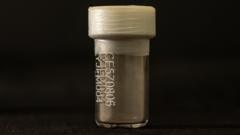In an extraordinary event for the scientific community, the UK has received its first samples of Moon dust in nearly half a century, courtesy of China's Chang'e 5 space mission. The precious lunar material, loaned to the UK, is now securely stored within a high-security facility in Milton Keynes, where Professor Mahesh Anand is the sole scientist conducting research on this rare find.
Professor Anand describes the Moon dust as "more precious than gold dust," emphasizing the significance of this rare opportunity. Having traveled to China to personally collect the samples, he expressed gratitude, noting, "Nobody in the world had access to China's samples, so this is a great honor and a huge privilege." The dust, collected from a volcanic region named Mons Rümker during the 2020 mission, could hold key evidence supporting the theory that our Moon formed from debris following a colossal collision between Earth and a Mars-sized planet around 4.5 billion years ago.
The Chang'e 5 mission marked a pivotal moment in space exploration, as it was the first successful lunar sampling mission since a Soviet mission in 1976 and has positioned China as a leader in the evolving space race. As part of a commitment to international collaboration, China has allowed seven researchers from across the globe to study the samples, embracing a spirit of scientific partnership.
Professor Anand revealed that his team plans to analyze the dust through cutting-edge techniques involving grinding and laser zapping, aiming to unlock secrets about the Moon's formation and early planetary conditions. The meticulous handling of the samples is paramount, as any contamination by terrestrial material could compromise their analysis.
Inside a high-security lab, the Moon dust is stored within vials that might seem unremarkable at first glance—a mere 60mg in total—but Professor Anand assures that this tiny amount will provide ample research opportunities for years to come. Lab technician Kay Knight, who will conduct initial analyses, conveyed her excitement and apprehension, knowing the rarity of the samples at stake.
To facilitate groundbreaking research, the team has access to specialized machinery designed to extract valuable information from the precious dust. This equipment allows them to study its components at extreme temperatures and analyze the gases and other elements present.
As scientific efforts progress, the research is expected to conclude within a year, though the analysis process itself may lead to the destruction of essential samples. With China already planning future lunar missions, including the upcoming Chang'e 6, expectations are high that the collaboration between countries will continue to flourish, leading to a deeper understanding of the Moon and its mysteries.
Professor Anand hopes that this partnership reflects a larger tradition of collaboration within the global scientific community, building upon the legacy established by the Apollo missions. "I believe this is just the beginning of a long-term collaboration between China and international scientists," he concluded, emphasizing the potential for shared discoveries on this shared celestial frontier.
Professor Anand describes the Moon dust as "more precious than gold dust," emphasizing the significance of this rare opportunity. Having traveled to China to personally collect the samples, he expressed gratitude, noting, "Nobody in the world had access to China's samples, so this is a great honor and a huge privilege." The dust, collected from a volcanic region named Mons Rümker during the 2020 mission, could hold key evidence supporting the theory that our Moon formed from debris following a colossal collision between Earth and a Mars-sized planet around 4.5 billion years ago.
The Chang'e 5 mission marked a pivotal moment in space exploration, as it was the first successful lunar sampling mission since a Soviet mission in 1976 and has positioned China as a leader in the evolving space race. As part of a commitment to international collaboration, China has allowed seven researchers from across the globe to study the samples, embracing a spirit of scientific partnership.
Professor Anand revealed that his team plans to analyze the dust through cutting-edge techniques involving grinding and laser zapping, aiming to unlock secrets about the Moon's formation and early planetary conditions. The meticulous handling of the samples is paramount, as any contamination by terrestrial material could compromise their analysis.
Inside a high-security lab, the Moon dust is stored within vials that might seem unremarkable at first glance—a mere 60mg in total—but Professor Anand assures that this tiny amount will provide ample research opportunities for years to come. Lab technician Kay Knight, who will conduct initial analyses, conveyed her excitement and apprehension, knowing the rarity of the samples at stake.
To facilitate groundbreaking research, the team has access to specialized machinery designed to extract valuable information from the precious dust. This equipment allows them to study its components at extreme temperatures and analyze the gases and other elements present.
As scientific efforts progress, the research is expected to conclude within a year, though the analysis process itself may lead to the destruction of essential samples. With China already planning future lunar missions, including the upcoming Chang'e 6, expectations are high that the collaboration between countries will continue to flourish, leading to a deeper understanding of the Moon and its mysteries.
Professor Anand hopes that this partnership reflects a larger tradition of collaboration within the global scientific community, building upon the legacy established by the Apollo missions. "I believe this is just the beginning of a long-term collaboration between China and international scientists," he concluded, emphasizing the potential for shared discoveries on this shared celestial frontier.



















